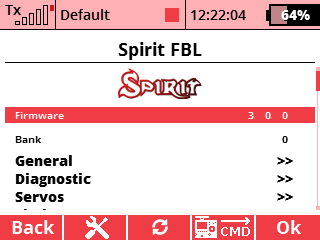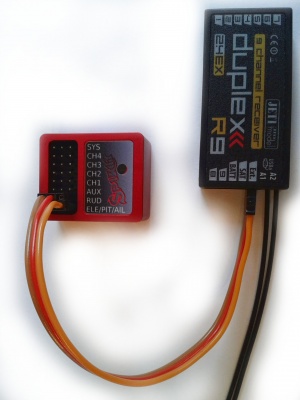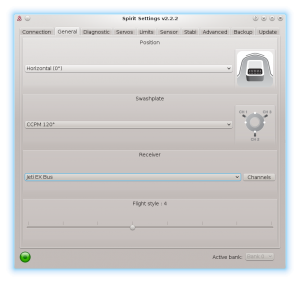Jeti Integration
From version 1.1.0 you can use the JETI integration! This mean you can fully configure Spirit units with JETI transmitters in real-time without need of a computer.
Contents
1 Requirements
To make it work you will need:
- Jeti Duplex transmitter: DC/DS 12, 14, 16 or 24
- Jeti Duplex receiver with a free EX port.
- Jeti Integration cable available in our stores (not for Spirit 3, GT).
- Integration BIN file for the transmitter - Click at the JETI icon at the linked page.
2 Wiring
2.1 Spirit 1, Spirit Aero, Spirit 2, Spirit Pro
PHOTO: Jeti Integration Cable
The Jeti cable is able to transfer everything including channel data and telemetry. This mean that you will not need to connect anything else except this cable.
2.2 Spirit 3, Spirit GT
Spirit 3 and Spirit GT require only stright cable supplied with the unit itself. Cable must be connected at the RUD port with no modification.
2.3 Spirit RS, Spirit GTR
These units have integrated JETI receiver. It is not needed to do any of these wiring or settings.
2.4 microSpirit
These units require special version of the JETI integration cable designed for microSpirit. It is available in the Spirit System eshop.
2.5 JETI receiver side
At the receiver side the servo connector must be connected to the EX Bus port.
- For new REX receivers the port is called E1 or E2 (EXT port will not work).
- For older EX receiver the port label is always called EXT.
If you are using EX receivers with attached telemetry sensor to the EXT port in this case you have two options:
- To use UDI connection (SRXL/SUMD receiver type) - in this case you will loose the Jeti Integration.
- To buy a REX receiver where you can use a telemetry sensors and the Jeti integration together.
3 Transmitter preparation
Now download Configuration file from our Spirit web page by clicking at the JETI icon at the bottom of the web page, which has ZIP extension. The file archive must be extracted first (by Right click). You will obtain SPIRIT-3-X folder. Content of this folder must be copied to the Devices directory at the SD-Card of your transmitter. Without this you will see an error message when the Spirit device is opened.
This mean Devices directory will contain SPIRIT.bin file and SPIRIT directory with images inside.
You can copy it by connecting micro USB cable to the transmitter similarly as to an USB flash drive. When cable is attached to the transmitter you have to confirm the USB connection. Then simply drag and drop content of the SPIRIT-3-3 to the Devices directory as you are used to.
It is very important to use the same version of the BIN file as your current firmware in the unit. If the versions are not matching then an incompatibility issues could occur.
4 Spirit Settings
Now you are ready to power up the unit. If your Power supply is not connected yet, we recommend to connect it to the AUX1, AUX2 and/or CH0 port. Before you can utilize the Jeti Integration and EX Bus connection, it is important to set the EX Bus receiver type in the General tab of the software. Please start the Spirit Settings and change the receiver type as displayed on the photo. Then save the settings (e.g. by CTRL+S) or the Backup tab/Unit - Save and restart the unit.
5 Integration Menu
When unit is initialized you will be able to enter the Jeti Integration menu. Press the MENU button at the transmitter.
Then select the Model menu by a rotary knob.
And then enter the Device Explorer menu.
There, if the wiring and receiver type is correct, you will see the Spirit entry.
5.1 Still can't see the Spirit?
If you have everything right but the unit is still not visible, then the only problem can be that the EX Bus port of your receiver is configured to a different protocol.
In this case, enter the configuration menu of your receiver in the Device Explorer - the entry has name of your receiver. Change the Serial Link to the EX Bus. In case of the REX receivers you can assign E1 or E2 port to EX Bus in the Alternative Pin Config menu.
6 Usage
Whenever you want to configure a parameter, go to the Model/Device Explorer/Spirit. There the Menu Layout is nearly identical with the PC software to have easy navigation.
It is working in the same way as when the PC software is connected. This mean that when Jeti Integration menu is opened, you can change even the basic parameters that could affect the helicopter significantly.
When using the Bank Switching or Real-Time tuning features the menu will take full control of it. The unit will not react to a Switch position changes. For the Bank Switching there is a menu Bank Switching where you can manually change the banks.
Always close the integration menu with Close the menu. Otherwise Bank Switching or Real-Time tuning features will be temporarily disabled.
Do not forget to click the Save Settings when you want to save a changes permanently.
7 Preset for transmitter
You can use our preconfigured profile for the transmitter where everything should be configured to be ready to fly.
The profile has enabled:
- Flight modes
- Bank Switching
- Rescue/Stabilisation modes (activated by a Separate channel)
You can download it right here (Optimized for Jeti DS-14). Then unzip the file and save the JSN file to your transmitter (SDCard) to the Model directory.
In your transmitter there will be new profile called Spirit FBL that you can select.
Enjoy the integration!
8 Channel Mapping
In case that your channels are not matching, we recommend to leave default channel mapping in the unit and to change it in your transmitter.
You can do so in the Model - Servo Assignment menu.
Channel Layout:
- Throttle
- Aileron
- Elevator
- Pitch
- Rudder
- Gyro sens.
- Bank (if used)
- Stabi (if used)
9 Telemetry data
In order to display Telemetry data you have to scan for new sensors first. Go to Menu - Timers/Sensors - Sensors/Logging Setup and then press AUTO button. Scanning will take a few seconds untill all Telemetry variables will show up.
- S Vibes [%] - Vibration level from all axes (0 - 10% is normal level)
- S RPM [Head RPM] - RPM provided by RPM sensor.
- S Voltage [V] - ESC Telemetry | Main Battery voltage
- S Current [A] - ESC Telemetry | Main Battery current
- S Capacity [mAh] - ESC Telemetry | Main Battery consumed capacity
- S Temp [°C] - ESC Telemetry | FET temperature
- S Altitude [m] - Model altitude measured from lift off position.
- S Speed [km/h] - Flight Speed of the model measured by Spirit GeoLink module.
Once scanning is finished you can add these variables onto the main screen. Go to Menu - Timers/Sensors - Displayed Telemetry and press the ADD button. Add all Telemetry data you want to display.










